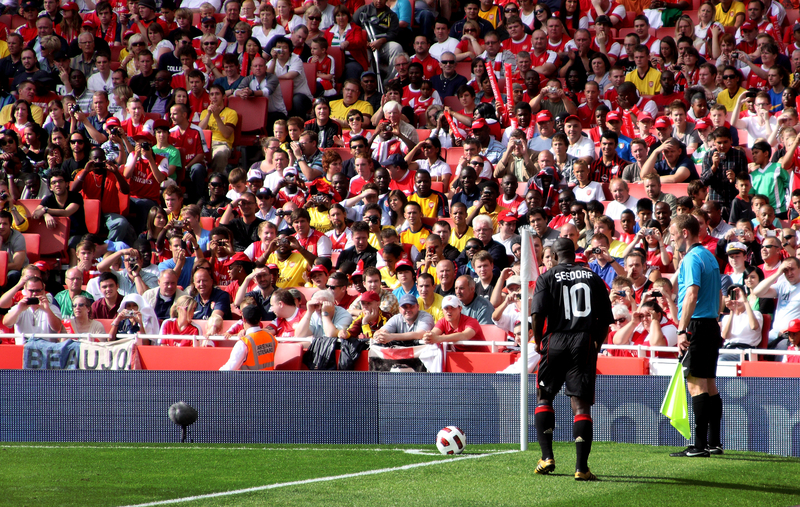Last updated on November 8th, 2023 at 10:16 am
A corner kick during a soccer game occurs when the ball travels past the goal line, goes out of bounds, and the last touch comes from the defending team. Once the ball goes out of bounds, the ball stays in the corner arc nearest to where the ball went out of bounds, and the corner flag post doesn’t move during the kick.
Any player can take the kick in the nearest corner of where the ball went out, but they can’t touch it again until another player makes contact with it. All defenders need to be at least 10 yards away from where the kick occurs.
If the corner taker kicking from the arc touches the ball again before another player does, it results in a free kick for the defending team where the penalty occurs. Also, any attacking player who makes contact with the ball on a corner kick won’t receive offsides.
What if you Kick the Ball into Your Own Goal via a Corner Kick?
The laws of the game state that a kicker can’t score against sending the soccer ball through their own goalposts during a corner kick. A new corner kick occurs from the opposing team to resume play if that happens. However, this will be extremely rare if it does occur during a match.
How Successful are Corner Kick Goals in Soccer?
According to Sports Stack Exchange, a corner kick that results in a goal is rare at 1.42%. During the 2010 Word Cup, a goal via corner kick was one out of every seventy chances. A Reddit thread data analysis breakdown had a successful corner kick goal at 1.27%.
How to Take a Corner Kick Towards the Opposing Teams Penalty Area
If you are looking to kick the ball towards the goal area, you should plan to curve the ball’s trajectory. To curve the ball, you want to angle your kick using the inside of your foot. One note is that you should have a right foot kicker on the left side of the corner of the pitch and vice versa.
As you kick through the ball with this angle, you want to create air time for the ball to get to a teammate or increase a scoring opportunity via a header or a kick. Also, as the kicker, you can’t kick the ball again until another player touches it after your kick.
What is a Short Corner Kick?
While you can kick the soccer ball towards the opposing team goalie, you can also take a short kick from the corner area. One popular short corner kick is the overlap. An overlap play has the kicker pass the ball a short distance to their teammate, and their teammate either gives it back to the original kicker or can take the ball themself. A short corner kick is a great strategy to pull a defender away from the goalkeeper and help set up an offensive play.
How to Play Offense on a Corner Kick
The offense tends to line up near the goal outside of the kicker taking the kick. Stacking offensive players near the goalie on a corner kick can result in a goal via a header or kick. Sometimes, you will see an offensive team have one or two players near the corner arch to perform a short kick or draw a defender away from the goalie.
How to Defend against the Corner Kick
The defending team must stay at least ten yards away from the corner kick on the soccer field or receive a yellow card. Ensuring that they are ten yards away from the kicker, most teams line up a wall of defenders near the goalie to stop players from having a clear shot on the goal. Teams can also move players around the pitch to either stack everyone near the goal or evenly space them out around the field.
Is a Corner Kick a Direct Kick?
A corner kick during a soccer match is a direct kick.
Conclusion: What is a Corner Kick in Soccer?
In summary, a corner kick occurs when a defending team player last touches the ball after it passes the goal line and goes out of bounds. A successful Olympic goal is rare at around 1.5%. With it being rare, teams try and place the ball towards their teammates during a corner kick. Usually, a referee won’t count the extra time it takes for a player to take a corner kick. However, if there is ample time that a player takes before finally kicking the ball, they might.
Similar Posts:
What is a Penalty Kick in Soccer?
What is a Friendly Match in Soccer?
What is a Hat Trick in Soccer?
Greg Kristan, owner of The Stadium Reviews, LLC and TM Blast, LLC, brings his extensive experience visiting over half of the MLB ballparks, along with numerous MLS, NHL, NBA, and NFL venues, to provide in-depth coverage on the bag policy, food options, and parking. He has also been interviewed about his experiences on several sports podcasts.






